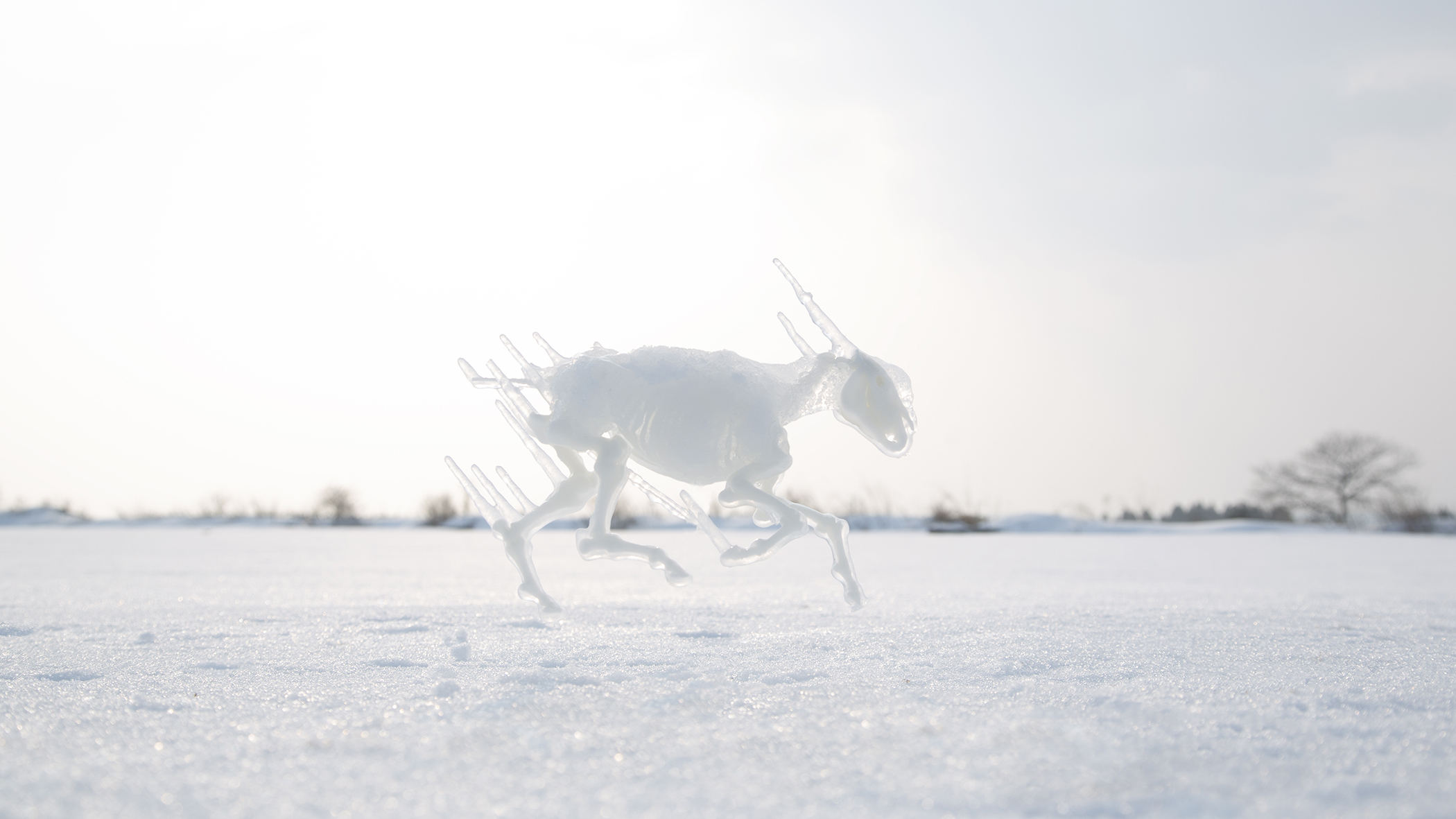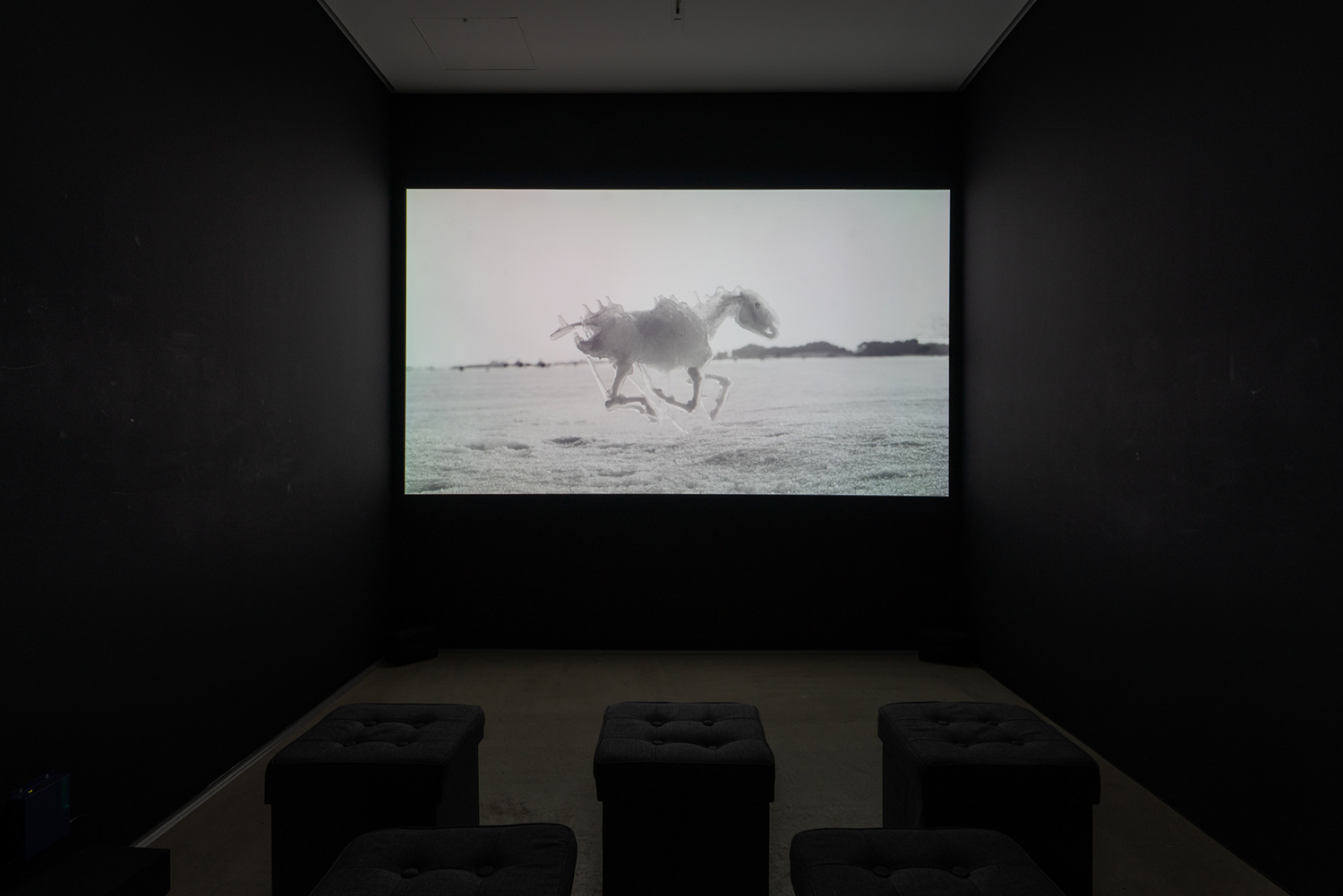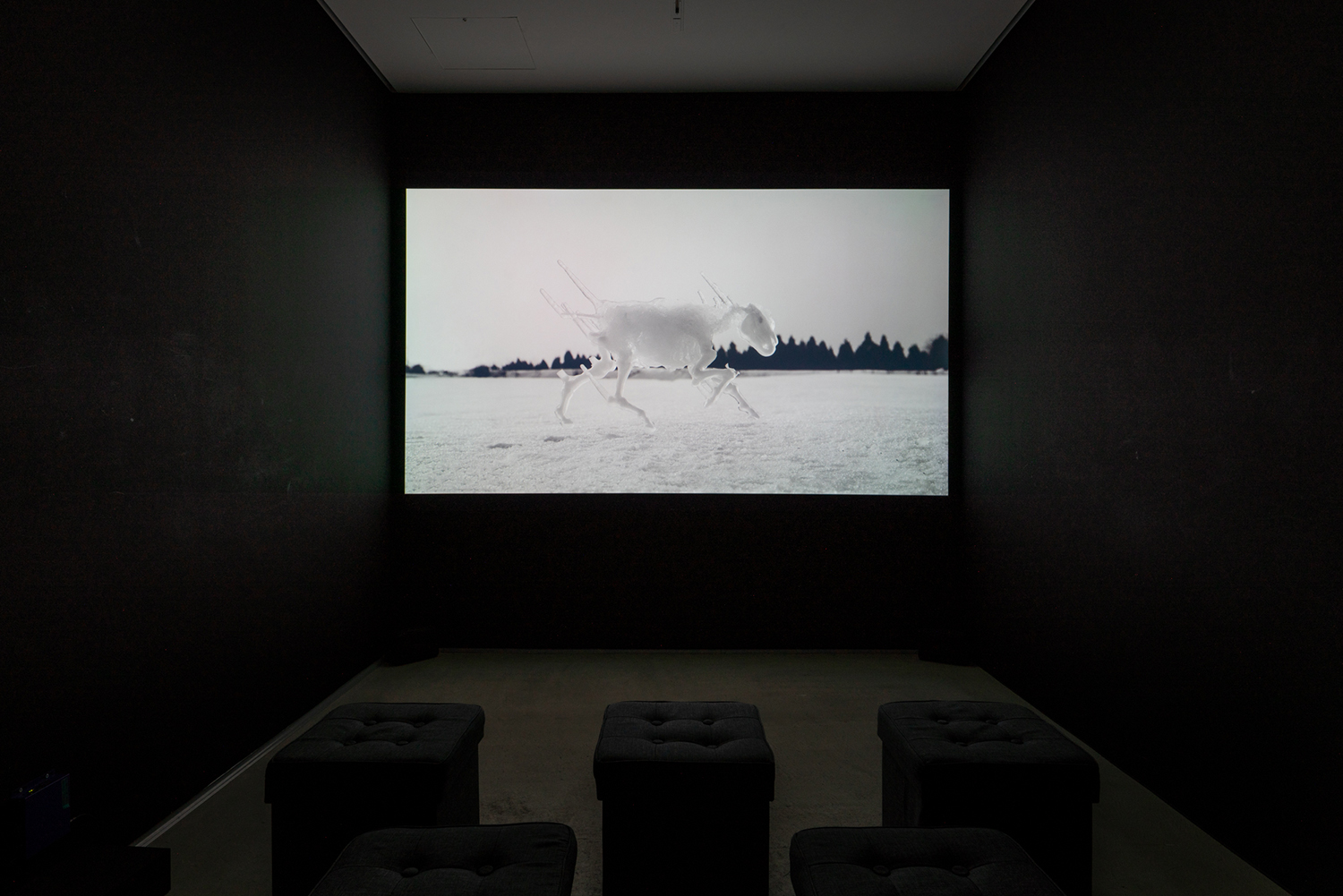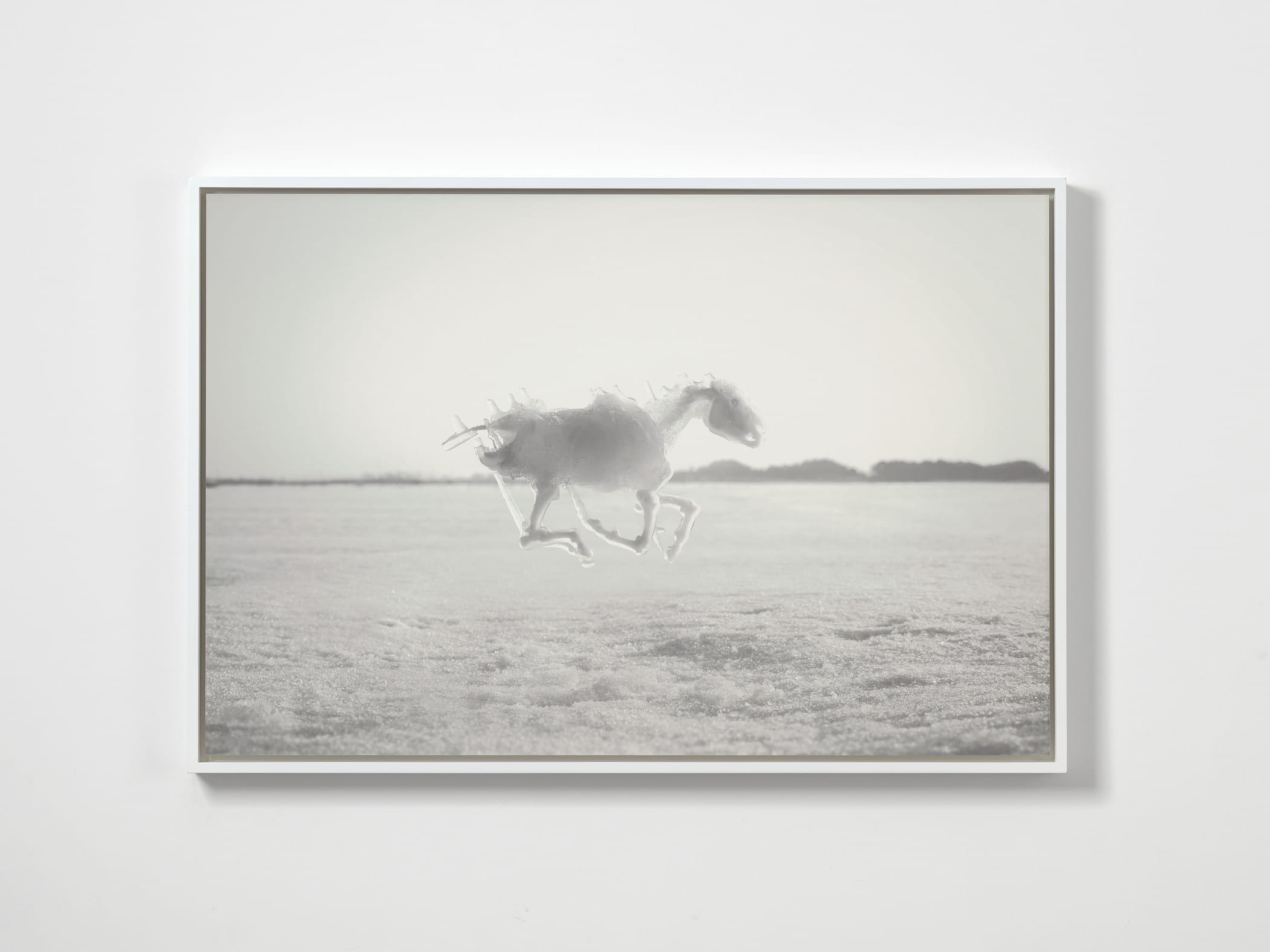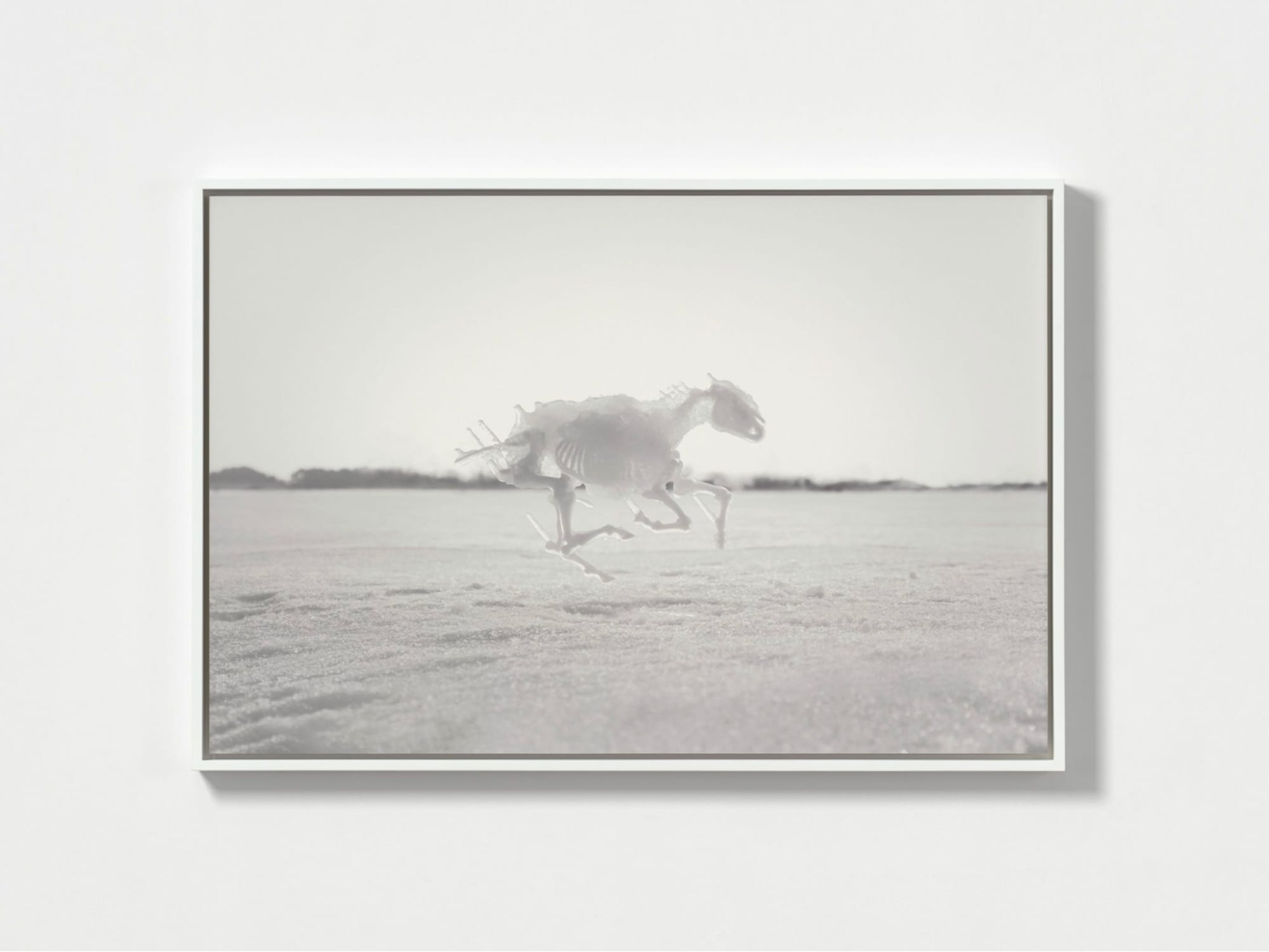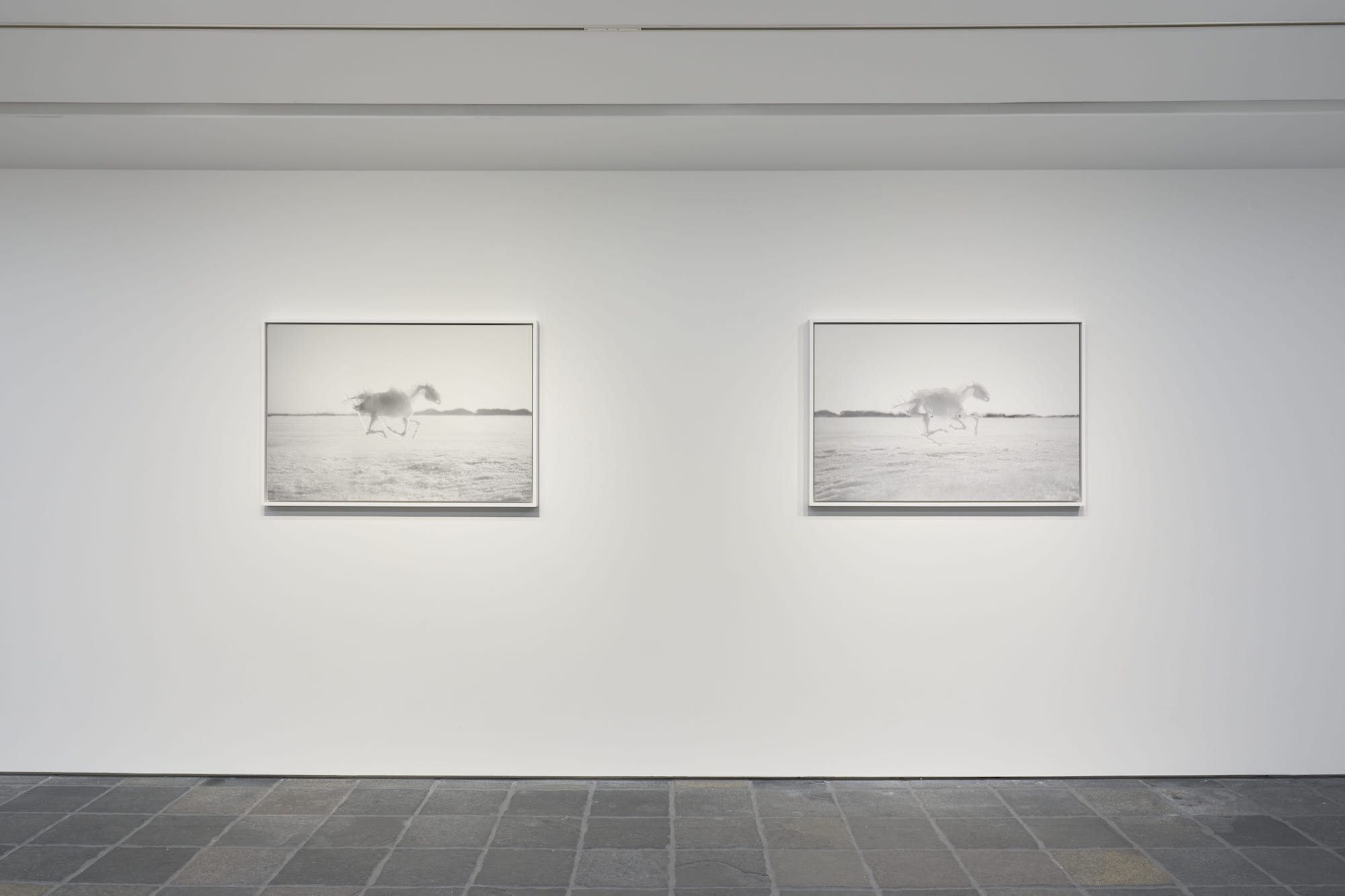Galloping Nambu breed horseギャロップする南部馬
2019
4K video
The Nambu horse is a breed of horse unique to Japan that is now extinct. This animation work, Galloping Nambu breed horse, depicts it resurrected as an ice sculpture, running across a snowfield.
The Nambu stallion is extolled in the Gosen Wakashu, a tenth-century (Heian Period) anthology of waka poetry, but pure Nambu horses disappeared as a result of reforms in the Meiji Period (1868–1912) that required native Japanese horses to be crossed with foreign breeds as part of efforts to boost Japan’s wealth and military strength. There are few extant records of these horses, but based on the skeleton of the last Nambu horse—preserved at the Morioka Agricultural High School—the artist created twelve sculptures, outputting them in 3D and freezing them in conditions that would form icicles to bulk up their surfaces, thereby resurrecting the Nambu breed as translucent white horses with thin coats of ice.
The sight of a pure white horse running free and happy in the snow of Aomori—which has deep snowfalls in winter—is beautiful, a fairy tale ending. Nevertheless, Nambu horses were selectively bred to enhance their role, which involved functioning as a means for transporting goods for farmers, as weapons for soldiers to fight with, or as eye-candy and a symbol of financial power for nobility. Eventually, the cross-breeding to produce stronger battle horses under the Meiji restoration reforms resulted in the Nambu horses disappearing into the gene pool of mixed breeds. Thinking of its history of being manipulated and pushed around by humanity, the resurrection of this horse in ghostly form can be interpreted as a critical comment on human activity in the Anthropocene.
Galloping Nambu breed horse is also an homage to Eadweard Muybridge’s groundbreaking photographs of horses in motion which consisted of series of shots in quick succession and became a vital step in the development of motion pictures. Shooting this animation in monochrome gives it a nostalgic air, harking back to the time of gelatin-silver photographs and black-and-white movies. The sense of loss for the Nambu horse, which disappeared with the advent of newer technology, is accentuated by shooting in analog technology from the early days of photography, rather than using today’s digital technology.
(Text: Yohsuke Takahashi)
This work was produced during an on-site residency for my solo exhibition atTowada Art Center. In the past, Towada City in the Aomori Prefecture was one of Japan’s leading horse breeding regions. The Nambu breed Horse, a Japanese stallion raised at that time, is now extinct despite having been a key presence that supported the lives of the local people. Although there are a few references to date that present an accurate physical description of the Nambu breed horse, a skeleton specimen of “Mori-go,” the last great stallion of its kind, remains preserved at Morioka Agricultural High School. I restored the legendary horse based on the reference documents I found, and made an animation work of it running across the snowfi elds of Towada.
Back in the 19th century, it was very common for people and horses to live together under one roof in Japan. These traditional L-shaped houses were known as “Nambu Magariya” (Nambu Bent House). Here, the residence (main house) where people lived, were connected to the horse stables. Such houses still remain in various parts of Japan, especially in the former provinces of the Nambu clan (the region that spans eastern Aomori., northern and central Iwate, and northeast Akita). There were indeed times when humans had used horses to cultivate fi elds, as well as carry and transport heavy loads. Perhaps in
these days there was a perceptive world of sorts that existed through a communication with horses.
* Reprinted from AKI INOMATA, Significant Otherness, tr. Kei Benger, Tokyo: Bijutsu Shuppan-sha, 2020, p.133.
《ギャロップする南部馬》は、絶滅した日本固有の馬種である「南部馬」が氷像となって蘇り、雪原を走る映像作品である。
平安時代の後撰和歌集にも名馬として詠まれた「南部馬」は、明治期の富国強兵政策の中で外来種との交雑が進められ純血種はもはやどこにも存在しない。その姿を今に伝える資料は少ないが、作家はまず、盛岡農業高校に残されていた最後の南部馬の骨格標本を手掛かりに、12体の馬をCGで造形し、3D印刷した。そして、それを氷柱のように凍らせることで表皮を肉付けし、白く透き通った薄氷の馬として蘇生した。
冬の雪積もる青森の雪景色を嬉々として走る白馬は、オシラ様の伝承が残る東北の地ならではの題材であり、神話のように美しい。東北地方の亜高山帯特有の樹氷現象が表現技法に応用されることで、本作では、主題だけでなく、技法においても地域固有性が探求されている。
しかし同時に、南部馬は、農民にとっては貨物輸送の道具として、武士にとっては戦のための兵器として、貴族にとっては財力誇示・鑑賞用として品種改良され、最後は近代化の中で騎兵力向上のために雑種となり絶滅した馬である。人間に振り回されて続けたその歴史を思えば、本作は「人新世」における業を、幽霊のような姿で蘇らせることで批評していると解釈できる。
加えるなら、映画誕生前史のひとつであるエドワード・マイブリッジの歴史的な傑作「ギャロップする馬」へのオマージュとなっていることは、かつての銀塩写真・モノクロ映画が持っていた「懐かしさ」を作品に与えている。本作では、道具としての南部馬が新しい技術の登場とともに消えていった喪失感を、あえて今デジタル化ではなく黎明期の写真のアナログな技法を取り込むことで、補完している。
(文責:高橋洋介)
学生の頃、毎日暗室に籠ってはモノクロ写真の紙焼きに明け暮れていた。暗闇の中での、わずかな視覚と触覚、そして勘に頼った作業を続けて行くと、第六感のような何かが覚醒してくるような感覚があった。見えないものとのインタラクションから見えるものをつくっていく。あの不思議な感覚は、今でも時折蘇ってくる。アナログからデジタルカメラへと移行が進み、当時使っていたフィルムや印画紙は廃盤になってしまった。大学のカリキュラムからも暗室作業は撤廃されつつある。
100年前まで、私たちの家に馬が同居することは、とても一般的だった。馬とともに畑を耕し、ものを運び、移動していた時代。そこには馬とのコミュニケーションによって、存在していた環世界のようなものがあったのではないかと想像する。
この作品は、十和田市現代美術館での滞在制作によって作られた。青森県の十和田市は、かつて日本有数の馬の産地であった。当時、育てられていた和種馬である「南部馬」は、暮らしを支える存在であったにもかかわらず、現在では絶滅してしまっている。正確な南部馬の姿形を今に伝える資料は少ないが、最後の南部馬とされる「盛号」の骨格標本が盛岡農業高校に残っている。その標本を元に復元した幻の南部馬の骨格を十和田の雪原に走らせ、エドワード・マイブリッジによる世界最初の連続写真《ギャロップする馬》へのオマージュとして、アニメーション作品にした。
(AKI INOMATA)



